David B. Weishampel | |
|---|---|
| Born | November 16, 1952 |
| Nationality | American |
| Scientific career | |
| Fields | Paleontology |
| Institutions | Johns Hopkins University |
Professor David Bruce Weishampel (born November 16, 1952) is an American palaeontologist in the Center for Functional Anatomy and Evolution at Johns Hopkins University School of Medicine. Weishampel received his Ph.D. in Geology from the University of Pennsylvania in 1981. His research focuses include dinosaur systematics, European dinosaurs of the Late Cretaceous, jaw mechanics and herbivory, cladistics and heterochrony and the history of evolutionary biology. Weishampel's best known published work is The Dinosauria University of California Press; 2nd edition (December 1, 2004). He consulted for Jurassic Park and is a good friend of Steven Spielberg. He has received an Academy Scientific and Technical Award.
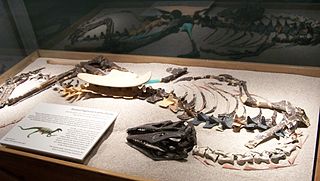
Coeluridae is a historically unnatural group of generally small, carnivorous dinosaurs from the late Jurassic Period. For many years, any small Jurassic or Cretaceous theropod that did not belong to one of the more specialized families recognized at the time was classified with the coelurids, creating a confusing array of 'coelurid' theropods that were not closely related. Although they have been traditionally included in this family, there is no evidence that any of these primitive coelurosaurs form a natural group with Coelurus, the namesake of Coeluridae, to the exclusion of other traditional coelurosaur groups.

Nemegtosauridae is a family of titanosaurian sauropod dinosaurs based on their diplodocid-like skulls. Only three species are known: Nemegtosaurus, Quaesitosaurus and Tapuiasaurus, each from the Cretaceous.
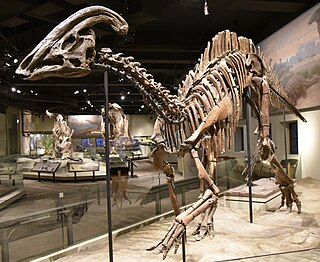
Parasaurolophus is a genus of herbivorous hadrosaurid ornithopod dinosaur that lived in what is now North America and possibly Asia during the Late Cretaceous Period, about 76.5–73 million years ago. It was a herbivore that walked both as a biped and as a quadruped. Three species are universally recognized: P. walkeri, P. tubicen, and the short-crested P. cyrtocristatus. Additionally, a fourth species, P. jiayinensis, has been proposed, although it is more commonly placed in the separate genus Charonosaurus. Remains are known from Alberta (Canada), New Mexico and Utah, and possibly Heilongjiang (China). The genus was first described in 1922 by William Parks from a skull and partial skeleton found in Alberta.
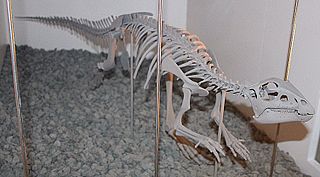
Hypsilophodontidae is a traditionally used family of ornithopod dinosaurs, generally considered invalid today. It historically included many small bodied bipedal neornithischian taxa from across the world, and spanning from the Middle Jurassic until the Late Cretaceous. This inclusive status was supported by some phylogenetic analyses from the 1990s and mid 2000s, although there have also been many finding that the family is an unnatural grouping which should only include the type genus, Hypsilophodon, with the other genera being within clades like Thescelosauridae and Elasmaria. A 2014 analysis by Norman recovered a grouping of Hypsilophodon, Rhabdodontidae and Tenontosaurus, which he referred to as Hypsilophodontia. All other analyses from around the same time have instead found these latter taxa to be within Iguanodontia.

Saurolophus is a genus of large hadrosaurid dinosaur from the Late Cretaceous period of Asia and North America, that lived in what is now the Horseshoe Canyon and Nemegt formations about 70 million to 68 million years ago. It is one of the few genera of dinosaurs known from multiple continents. The type species, S. osborni, was described by Barnum Brown in 1912 from Canadian fossils. A second valid species, S. angustirostris, is represented by numerous specimens from Mongolia, and was described by Anatoly Konstantinovich Rozhdestvensky.

Appalachiosaurus is a genus of tyrannosauroid theropod dinosaur from the Late Cretaceous Period of eastern North America. Like almost all theropods, it was a bipedal predator. Only a juvenile skeleton has been found, representing an animal over 7 meters (23 ft) long and weighing over 600 kilograms (1300 lb), which indicates an adult would have been even larger. It is the most completely known theropod from the eastern part of North America.

Animantarx is a genus of nodosaurid ankylosaurian dinosaur from the Upper Cretaceous of western North America. Like other nodosaurs, it would have been a slow-moving quadrupedal herbivore covered in heavy armor scutes, but without a tail club. The skull measures approximately 25 cm in length, suggesting the animal as a whole was no more than 3 meters long.
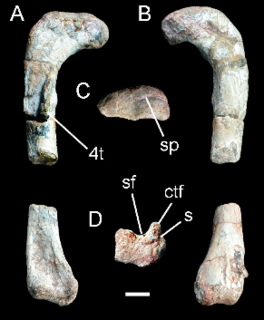
Alwalkeria is a genus of basal saurischian dinosaur from the Late Triassic, living in India. It was a small bipedal omnivore.
Jeffrey A. Wilson, also known as JAW, is a paleontologist and professor of geological sciences and assistant curator at the Museum of Paleontology at the University of Michigan.

Wannanosaurus is a genus of basal pachycephalosaurian dinosaur from the Campanian-age Upper Cretaceous Xiaoyan Formation, about 80 million years ago (mya) in what is now Anhui, China. The type species, Wannanosaurus yansiensis, was described by Hou Lian-Hai in 1977.

Anasazisaurus is a genus of saurolophine hadrosaurid ("duckbill") ornithopod dinosaur that lived about 74 million years ago, in the Late Cretaceous Period. It was found in the Farmington Member of the Kirtland Formation, in the San Juan Basin of New Mexico, United States. Only a partial skull has been found to date. It was first described as a specimen of Kritosaurus by Jack Horner, and has been intertwined with Kritosaurus since its description. It is known for its short nasal crest, which stuck out above and between its eyes for a short distance.

Mymoorapelta is an ankylosaur from the Late Jurassic (Kimmeridgian-Tithonian) Morrison Formation of western Colorado, USA. The taxon is known from portions of a disarticulated skull, parts of three different skeletons and other postcranial remains. It is present in stratigraphic zones 4 and 5 of the Morrison Formation.

Emausaurus is a genus of thyreophoran or armored dinosaur from the Early Jurassic (Toarcian). Its fossils have been found in Mecklenburg-Vorpommern, northern Germany. Emausaurus is the only known Toarcian thyreophoran and it is also the only dinosaur from the zone of the same age with a formal name.

Saurischia is one of the two basic divisions of dinosaurs. In 1888, Harry Seeley classified dinosaurs into two orders, based on their hip structure, though today most paleontologists classify Saurischia as an unranked clade rather than an order.

Camarasauridae is a family of neosauropod dinosaurs within the clade Macronaria, the sister group to Titanosauriformes. Among sauropods, camarasaurids are small to medium-sized, with relatively short necks. They are visually identifiable by a short skull with large nares, and broad, spatulate teeth filling a thick jaw. Based on cervical vertebrae and cervical rib biomechanics, camarasaurids most likely moved their necks in a vertical, rather than horizontal, sweeping motion, in contrast to most diplodocids. Cladistically, they are defined to be all sauropods more closely related to Camarasaurus supremus than to Saltasaurus loricatus.

Halszka Osmólska was a Polish paleontologist who had specialized in Mongolian dinosaurs.
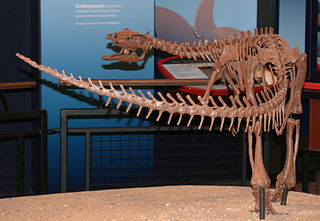
Parksosauridae is a clade or family of small ornithischians which have previously been generally allied to hypsilophodontids. Parksosauridae might be a synonym of Thescelosauridae since they possibly contain the same members.

Kritosaurini is a tribe of saurolophine hadrosaurid dinosaurs from the Late Cretaceous.

Thescelosauridae is a clade or family of small ornithischians which have previously been generally allied to hypsilophodontids. Thescelosauridae might be a synonym of Parksosauridae since they possibly contain the same members, although this has been disputed.